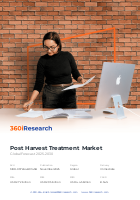
Post Harvest Treatment Market by Treatment Type (Biological Treatment, Chemical Treatment, Physical Treatment), Crop Type (Cereals & Grains, Fruits, Oilseeds & Pulses), Formulation, Application Mode, Application, End User, Distribution Channel - Global Forecast 2025-2030
SKU
MRR-0372A4B9143B
Region
Global
Publication Date
December 2025
Delivery
Immediate
2024
USD 2.72 billion
2025
USD 2.95 billion
2030
USD 4.45 billion
CAGR
8.54%

Download a Free PDF
Get a sneak peek into the valuable insights and in-depth analysis featured in our comprehensive post harvest treatment market report. Download now to stay ahead in the industry! Need more tailored information? Ketan is here to help you find exactly what you need.



